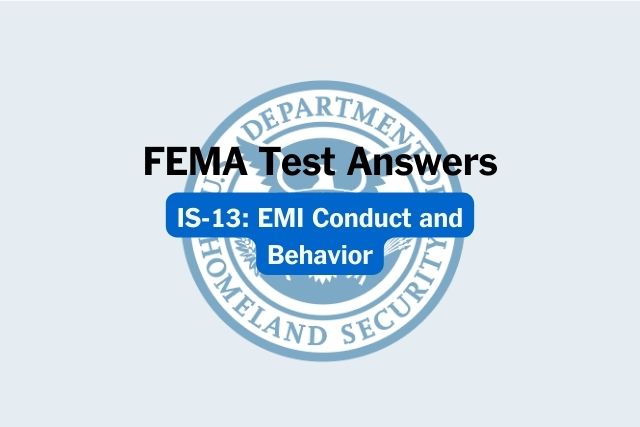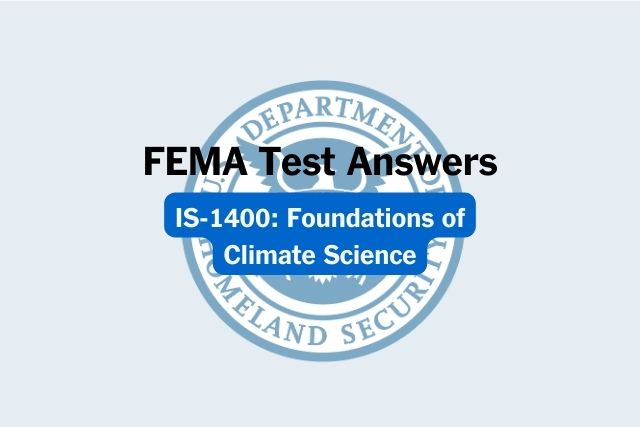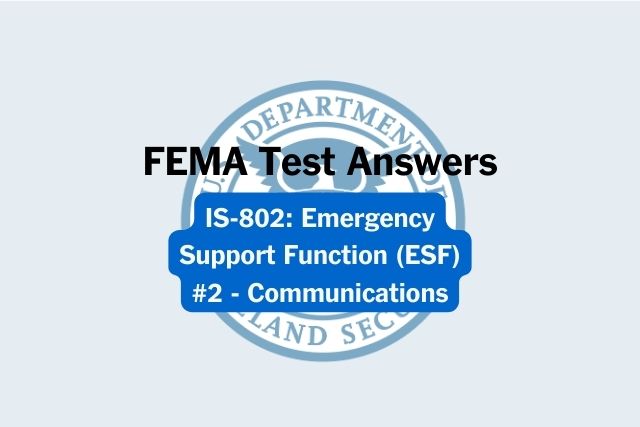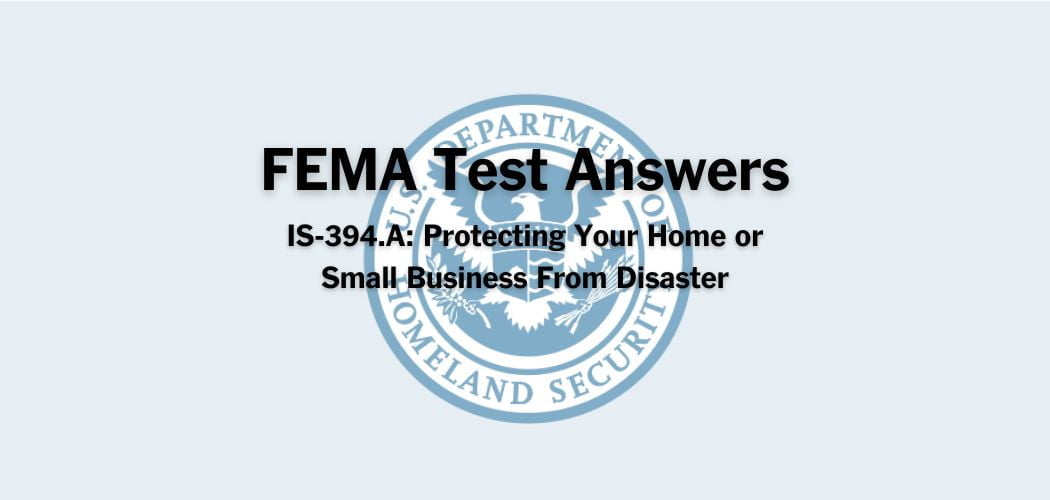Overview: The FEMA IS-1120 course was published on 6/19/2019 to provide information to individuals interested in Letters of Map Revisions (LOMRs) on the FEMA, state, and tribal or local community levels.
Primary audience: The IS-1120 course is for the whole community to understand the floodplain management and insurance implications of LOMRs.
FEMA IS-1120 test answers
Each time this test is loaded, you will receive a unique set of questions and answers. The test questions are scrambled to protect the integrity of the exam.
Question 1. Which is a role of the tribal or local community floodplain administrator (FPA) in the Letter of Map Revision (LOMR) process?
A. Review and deny Letter of Map Revision (LOMR) applications
B. Evaluate community compliance with minimum NFIP standards✅
C. Assist property owners with the Letter of Map Revision (LOMR) application when needed
D. Conduct surveys to collect metes and bounds data
Question 2. How can a tribal or local community floodplain administrator (FPA) communicate the need for continued flood insurance coverage to a property owner who has obtained a Letter of Map Revision–Based on Fill (LOMR-F) ?
A. Institute a tribal or local requirement to maintain insurance after Letter of Map Revision (LOMR) approval.
B. Point out that Preferred Risk Policies may also be available.
C. Explain that, even with a Letter of Map Revision–Based on Fill (LOMR-F) , flood risk remains and homeowner’s insurance does not cover damages from floods.✅
D. Reassure owners that Letters of Map Revision (LOMRs) will never need to be updated.
Question 3. A Letter of Map Revision-Based on Fill (LOMR-F) confirms a structure will not be inundated by the base flood, but more than 25% of all NFIP claims are from structures outside the Special Flood Hazard Area (SFHA). What does this imply for flood risk to a structure with a LOMR-F?
A. Flood Insurance Rate Maps (FIRMs) should be updated to reflect actual risk instead of insurance standards.
B. Other homeowners should have applied for Letters of Map Revision–Based on Fill (LOMR-Fs) preemptively.
C. Some residual flood risk remains even after a Letter of Map Revision–Based on Fill (LOMR-F).✅
D. Letters of Map Revision–Based on Fill (LOMR-Fs) shift the flood risk away from some structures onto others.
Question 4. In which special situation may the application fee for a Letter of Map Revision (LOMR) application be exempt?
A. When the applicant submits applications for multiple property sites in the same community
B. When the application was submitted simply to develop a Base Flood Elevation (BFE) when none had existed before
C. When no fill has been placed on the site
D. If the tribal or local community floodplain administrator (FPA) signed the Community Acknowledgement Form✅
Question 5. Which step in the FEMA Letter of Map Revision (LOMR) Review Process allows a LOMR to be filed at the Map Service Center?
A. Complete map revision determination
B. Determination if submittal is complete✅
C. Complete review of application package
D. Request additional data to support application
Question 6. A developer proposes to elevate a parcel of land in a Special Flood Hazard Area (SFHA) by placing fill. Which is the appropriate document to request?
A. Conditional Letter of Map Revision – Based on Fill (CLOMR-F)✅
B. Conditional Letter of Map Revision (CLOMR)
C. Letter of Map Revision (LOMR)
D. Letter of Map Revision – Based on Fill (LOMR-F)
Question 7. How can a licensed professional explain the remaining risk to a homeowner after a Letter of Map Revision–Based on Fill (LOMR-F) is issued?
A. Remind them that Preferred Risk Policies exist to generate income for FEMA
B. Remind them that even with a LOMR, flood risk remains and homeowner’s insurance does not cover damages from floods✅
C. Remind them that Letters of Map Revision–Based on Fill (LOMR-Fs) may be superseded at any time
D. Remind them that mitigation costs often outweigh flood insurance costs
Question 8. Which property location data is necessary for a Letter of Map Revision–Based on Fill (LOMR-F) application?
A. Photograph of the property location
B. Global Positioning System (GPS) coordinates of the property location
C. An annotated copy of the effective Flood Insurance Rate Map (FIRM) panel (including title block) showing the property location✅
D. Narrative description of the property location
Question 9. Which is a responsibility of a licensed professional surveyor in the Letter of Map Revision (LOMR) process?
A. Coordinate with community to resolve violations
B. Complete an Elevation Certificate
C. Ensure all permits are obtained
D. Determine Base Flood Elevations (BFEs) for Approximate A Zones✅
Question 10. Which describes a reason for tribes and communities to keep physical copies of Letters of Map Revision (LOMR)?
A. Letters of Map Revision (LOMRs) are never mailed to the community.
B. “B. Letters of Map Revision (LOMRs) change the flood map and may require community to formally adopt a new Flood Insurance Rate Map (FIRM) and/or Flood Insurance Study (FIS) tables or profiles. “✅
C. Letters of Map Revision–Based on Fill (LOMR-Fs) change flood hazard information, but do not change the flood map.
D. Letters of Map Revision (LOMRs) are only available on the FEMA Map Service Center site.
Question 11. Which survey data is required for a Letter of Map Revision–Based on Fill (LOMR-F) application?
A. Signed Community Acknowledgement Form
B. Copy of property deed with recorder’s seal
C. Street address of property
D. Elevation datum [National Geodetic Vertical Datum (NGVD) 1929 or North American Vertical Datum (NAVD) 1988]✅
Question 12. Which statement describes one purpose of the Community Acknowledgement Form?
A. It indicates to FEMA that the community is aware of actions that can impact floodplains.✅
B. It confirms that the applicant is aware of the Endangered Species Act.
C. It verifies the suitability of the development for a Letter of Map Revision (LOMR).
D. It affirms to the property owner that they obtained all necessary permits.
Question 13. What happens when a deadline is not met to provide additional data to FEMA?
A. The case is approved pending additional data.
B. The case moves forward without the data
C. The case is rejected entirely.✅
D. The case is suspended until data is received.
Question 14. How does a Letter of Map Revision–Based on Fill (LOMR-F) affect annual flood risk to a parcel?
A. Only Preferred Risk Policies are available to the property owner after a Letter of Map Revision–Based on Fill (LOMR-F).
B. Flood risk still remains, but homeowner’s insurance will cover damages from floods.
C. All flood risk is removed from the property.
D. Some flood risk still remains, and homeowner’s insurance will not cover damages from floods.✅
Question 15. Which is an implication of the issuance of a Conditional Letter of Map Revision (CLOMR)?
A. It provides evidence that a project, if built as designed, will meet all final Letter of Map Revision (LOMR) requirements.✅
B. It prevents a developer from making modifications to a project design.
C. It shields a project from future violations, if built as designed.
D. It guarantees that a project, if built as designed, will receive a final Letter of Map Revision (LOMR).
Question 16. Which is the last step a tribal or local floodplain administrator (FPA) can take if a potential violation is discovered during the Letter of Map Revision (LOMR) process, and the community has failed to achieve compliance after taking all legal steps available?
A. Issue notifications to the property owner or developer about the nature of the violation
B. Issue a Section 1316 letter to FEMA to remove the availability of flood insurance from the structure✅
C. Issue stop work orders or fines to the property owner or develop
D. Issue additional flood insurance to cover the potential losses from the property
Question 17. Which special situation requires the analysis of the extent of flooding, direction of sheet flow, and whether fill will convey the water flow to adjacent properties?
A. A Letter of Map Revision–Based on Fill (LOMR-F) request for a property in Zone AO✅
B. A Letter of Map Revision (LOMR) request for a property in Zone AH
C. A Letter of Map Revision (LOMR) request for a property in Zone AO
D. A Letter of Map Revision–Based on Fill (LOMR-F) request for a property in Zone AH
Question 18. Which is the first step a tribal or local floodplain administrator (FPA) can take if a potential violation is discovered during the Letter of Map Revision (LOMR) process, and the structure has received a certificate of occupancy or compliance?
A. Order the removal of materials that constitute the floodway violation
B. Issue stop work orders or fines
C. Send a Section 1316 letter to FEMA
D. Notify the owner about the nature of the violation(s)✅
Question 19. Which is the final step in the process to completing the Community Acknowledgement Form?
A. The tribal or local community floodplain administrator (FPA) signs the Community Acknowledgement Form.✅
B. The floodplain administrator (FPA) confirms that the request complies with all tribal or local community floodplain requirements.
C. The applicant or licensed professional submits the Letter of Map Revision (LOMR) request to tribal or local community floodplain administrator (FPA).
D. The floodplain administrator (FPA) determines that structures to be removed are reasonably safe from flooding.
Question 20. Which is the first step in the process to completing the Community Acknowledgement Form?
A. The tribal or local community floodplain administrator (FPA) signs and submits the request to FEMA.
B. The floodplain administrator (FPA) confirms that the request complies with all tribal or local community floodplain requirements.
C. The applicant or licensed professional submits the Letter of Map Revision (LOMR) request to tribal or local community floodplain administrator (FPA).✅
D. The floodplain administrator (FPA) determines that structures to be removed are reasonably safe from flooding.
Question 21. Which document serves as FEMA’s comment on a proposed project within the Special Flood Hazard Area (SFHA)?
A. Conditional Letter of Map Revision – Based on Fill (CLOMR-F)
B. Conditional Letter of Map Revision (CLOMR)✅
C. Letter of Map Revision (LOMR)
D. Letter of Map Revision – Based on Fill (LOMR-F)
Question 22. Which document establishes a property is not located in a Special Flood Hazard Area (SFHA) due to the placement of fill that does not increase the Base Flood Elevation (BFE) and will not be inundated by the base flood?
A. Conditional Letter of Map Revision – Based on Fill (CLOMR-F)
B. Conditional Letter of Map Revision (CLOMR)
C. Letter of Map Revision (LOMR)
D. Letter of Map Revision – Based on Fill (LOMR-F)✅
Question 23. When is a Conditional Letter of Map Revision (CLOMR) required?
A. To provide evidence that a proposed development will not result in a cumulative rise in the base flood elevation (BFE) of more than one foot at any point in the community✅
B. Always, when a future project will require a final Letter of Map Revision (LOMR) in order to secure funding
C. Only when required by tribal/local law or ordinance
D. When engineering studies show a need for a final Letter of Map Revision
Question 24. Common areas in a townhome subdivision develop extensive ponding after sustained rains. What is the probability and risk of this event?
A. High probability and high consequence
B. Low probability and high consequence
C. Low probability and low consequence
D. High probability and low consequence✅
Question 25. Which special situation requires a revised coastal analysis?
A. A Letter of Map Revision (LOMR) request for a property in Zone AO
B. A Letter of Map Revision–Based on Fill (LOMR-F) request for a property in Zone V
C. A Letter of Map Revision (LOMR) request for a property in Zone V
D. A Letter of Map Revision (LOMR) request for a property in Zone A✅
Question 26. Which step in the FEMA Letter of Map Revision (LOMR) Review Process allows the application to proceed to a detailed technical review?
A. Complete map revision determination
B. Determination if submittal is complete✅
C. Complete review of application package
D. Request additional data to support application
Question 27. To what extent is a tribe or community expected to remedy violations of local floodplain management ordinance?
A. To the satisfaction of the property owner
B. To the minimum possible
C. To the maximum possible✅
D. To the letter of the law only
Question 28. Which document serves as FEMA’s comment on a parcel of land or proposed structure in the Special Flood Hazard Area (SFHA) involving the placement of fill?
A. Conditional Letter of Map Revision – Based on Fill (CLOMR-F)✅
B. Conditional Letter of Map Revision (CLOMR)
C. Letter of Map Revision (LOMR)
D. Letter of Map Revision – Based on Fill (LOMR-F)
Question 29. Which question can a FEMA Reviewer ask to determine if the community understands the risks of development within a Special Flood Hazard Area (SFHA)?
A. Did the developer apply for a Conditional Letter of Map Revision–Based on Fill (CLOMR-F)?
B. Is the tribal or local community floodplain administrator (FPA) aware of this application?
C. Is there a signed Community Acknowledgement Form?
D. Is there a regulatory floodway?✅
Question 30. Which document allows FEMA to revise flood hazard information on a Flood Insurance Rate Map (FIRM) without physically revising and printing the entire map panel?
A. Conditional Letter of Map Revision – Based on Fill (CLOMR-F)
B. Conditional Letter of Map Revision (CLOMR)✅
C. Letter of Map Revision (LOMR)
D. Letter of Map Revision – Based on Fill (LOMR-F)
Question 31. Which is a responsibility of FEMA in the Letter of Map Revision (LOMR) process?
A. Review, approve or deny, or request additional data to support a Letter of Map Revision (LOMR) application✅
B. Conduct surveys to collect metes and bounds data
C. Ensure all permits are obtained
D. Coordinate Letter of Map Revision (LOMR) proposals with other departments
Question 32. What is one of the reasons for submitting a Letter of Map Revision (LOMR)?
A. To better align with existing road and highways maps
B. Jurisdictional boundaries have changed
C. Update information on flood risk or topography✅
D. To allow construction seaward of a primary frontal dune



